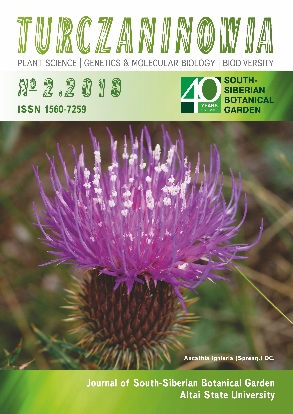Spore morphology of Selaginella borealis, S. sanguinolenta and S. helvetica (Selaginellaceae, Lycopodiophyta)
Abstract
For the first time we have conducted a study of three species of the genus Selaginella P. Beauv. from Russia: S. sanguinolenta (L.) Spring, S. helvetica (L.) Link and S. borealis (Kaulf.) Rupr. using the method of scanning electron microscopy (SEM). In a comparative analysis of the morphology of micro- and megaspores of S. sanguinolenta, S. helvetica and S. borealis, we first compiled an information on representatives of Selaginella from the territories of China and Russia. A distinctive feature of S. borealis and S. sanguinolenta based on the megaspore morphology is the different nature of the exosporium surface: S. borealis has the exosporium with rounded-polygonal tubercles, and S. sanguinolenta has the exosporium with roller-like folds rising above the sporoderma. S. sanguinolenta is characterized by following species-specific features of microspores: the presence of radially arranged convolutions on the proximal surface of the spore, outside the laesura, and convoluted folds on the distal surface of the microspores. S. helvetica is characterized by the following microspore morphology: the hemispherical distal side is in the equatorial position, and flat proximal side; the surface of the exosporium is granular, completely covered with rounded-polygonal tubercles. In the research we confirmed the presence of S. borealis in China (Yunnan). It has been established that the morphology of S. sanguinolenta microspores from the Khabarovsk Territory, the Republics of Buryatia, Tuva and the Irkutsk Region is identical to the microspores of representatives of S. sanguinolenta from China (Yunnan); and the morphology of S. helvetica microspores from the territory of the Chita Region, Trans-Baikal and Primorye Territories is identical to the morphology of the species samples from Liaoning Province (China).
Downloads
Metrics
References
Korall P., Taylor W. A. 2006. Megaspore morphology in the Selaginellaceae in a phylogenetic context: A study of the megaspore surface and wall structure using scanning electron microscopy. Grana 45: 22–60. DOI: 10.1080/00173130500520453.
Tryon A. F., Lugardon B. 1991. The spores of pteridophytes: surface, wall structure, and diversity based on electron microscopy studies. Springer, Berlin, 648 pp.
Цвелев Н. Н. О роде Selaginella P. Beauv. s. l. (Selaginellaceae) в России // Новости сист. высш. раст., 2004, Т. 36. С. 22–27.
Zhang X.-C., Kato M., Nooteboom H. P. 2013. Selaginellaceae. In: Flora of China. Vol. 2–3. Eds. Z. Y. Wu, P. H. Raven, D. Y. Hong. Science Press, Beijing; Missouri Botanical Garden Press, St. Louis, 37–66 pp.
Zhou X.-M., Jiang L.-J., Liang-Zhang, Gao X.-F., He Z.-R., Zhang L.-B. 2015a. Spore morphology of Selaginella (Selaginellaceae) from China and its systematic significance. Phytotaxa 237 (1): 1–67. DOI: 10.11646/phytotaxa.237.1.1.
Zhou X.-M., Rothfels C. J., Zhang L., He Z.-R., Le Péchon, T., He H., Lu N. T., Knapp R., Lorence D., He X.-J., Gao X.-F., Zhang L.-B. 2015b. A large-scale phylogeny of the lycophyte genus Selaginella (Selaginellaceae: Lycopodiopsida) based on plastid and nuclear loci. Cladistics 32: 360–389. DOI: 10.1111/cla.12136.
Zhou X.-M., Zhang L.-B. 2015. A classification of Selaginella (Selaginellaceae) based on molecular (chloroplast and nuclear), macromorphological, and spore features. Taxon 64 (6): 1117–1140. DOI: 10.12705/646.2.
Turczaninowia is a golden publisher, as we allow self-archiving, but most importantly we are fully transparent about your rights.
Authors may present and discuss their findings ahead of publication: at biological or scientific conferences, on preprint servers, in public databases, and in blogs, wikis, tweets, and other informal communication channels.
Turczaninowia allows authors to deposit manuscripts (currently under review or those for intended submission to Turczaninowia) in non-commercial, pre-print servers such as ArXiv.
Authors who publish with this journal agree to the following terms:
- Authors retain copyright and grant the journal right of first publication with the work simultaneously licensed under a Creative Commons Attribution License that allows others to share the work with an acknowledgement of the work's authorship and initial publication in this journal.
- Authors are able to enter into separate, additional contractual arrangements for the non-exclusive distribution of the journal's published version of the work (e.g., post it to an institutional repository or publish it in a book), with an acknowledgement of its initial publication in this journal.
- Authors are permitted and encouraged to post their work online (e.g., in institutional repositories or on their website) prior to and during the submission process, as it can lead to productive exchanges, as well as earlier and greater citation of published work (See The Effect of Open Access).





